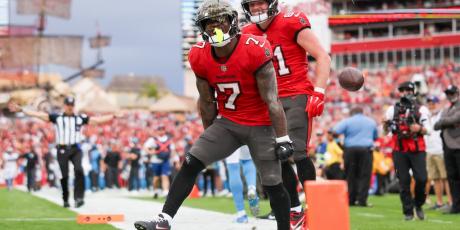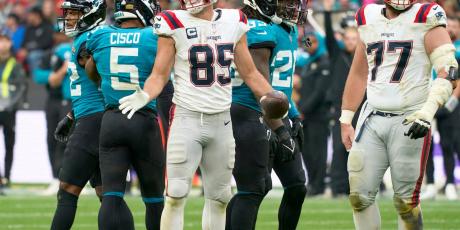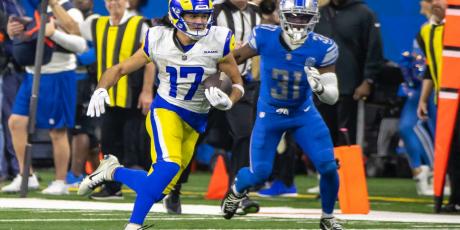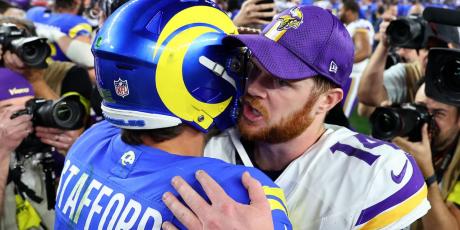Free Agency Winners & Losers: 27 Players You Need to Know About

NFL free agency never really ends, but the bulk of the big names have found new (or the same) homes for the 2015 season, so it’s a good time to take a look at how free agency has affected the value of players around the league. Let’s start with the…
RISERS
▲RB Frank Gore, Colts
Gore averaged 51.0 receptions from 2006-2010, but as soon as Greg Roman took over as offensive coordinator in 2011, his targets dropped precipitously. He averaged just 28.3 targets over the past four seasons, while the Colts' running backs accounted for 113 targets in 2014, so look for Gore's value to jump considerably in PPR formats. Due to his age, Gore typically goes later than he should in fantasy drafts, but he hasn't missed a game in three seasons and should be reinvigorated by a change of scenery. For more about Gore’s potential with the Colts, be sure to read The Case for Frank Gore in Indianapolis.
▲RB Jonathan Stewart, Panthers
Stewart was tremendous down the stretch, averaging 105 total yards (97.0 rushing) in the final seven games, including two playoff games. He averaged 5.30 YPC in that span, including 5.13 YPC versus Arizona and 5.38 YPC against Seattle in the playoffs. Over the final five games of the regular season, he was the #10 fantasy running back. He turns 28 in March, so there is definitely some tread left on his tires. Even though he has missed 20 percent of his team's games due to injury throughout the career, he’ll be a high-upside pick in the middle rounds with DeAngelo Williams finally out of the way. The Panthers are committed to running the ball and Stewart has talent. They plan to limit him to 15 carries per game, but he should be able to post RB2-type numbers with that workload.
▲RB C.J. Spiller, Saints
While New Orleans may not be an ideal landing spot from a workload standpoint, Spiller should have a big role in the passing game with Pierre Thomas, Jimmy Graham and Kenny Stills no longer on the roster. He’ll likely take over the role of Thomas, who averaged 11.6 touches over the last two seasons. Thomas finished with a top 30 PPG (PPR) in six of the last seven seasons, so that's a reasonable baseline for Spiller. New Orleans running backs caught 275 passes in the last two seasons, so there are plenty of catches to go around. In short, he has significant PPR upside in this offense, but his workload will be somewhat limited since he'll be part of a committee. For more on Spiller, check out The Case for C.J. Spiller in New Orleans.
▲WRs Alshon Jeffery & Marquess Wilson, Bears
With Brandon Marshall out of the way, Jeffery should dominate targets as the team’s obvious WR1. The Bears have been pass-heavy under Marc Trestman over the past two seasons, but new OC Adam Gase also ran a pass-heavy offense while in Denver, so we don’t expect that Jay Cutler’s pass attempts will drop significantly. Wilson likely starts opposite Jeffery, so his targets may increase the most of anyone on the roster with Marshall’s departure. Eddie Royal should serve as the team’s primary slot receiver.
▲RB Devonta Freeman, Falcons
With Steven Jackson out of the way, GM Thomas Dimitroff said there was “no question” Freeman is ready to be the feature back in Atlanta, though we’ll have to wait and see if the team adds a running back in the draft. Looking at the position, Kyle Shanahan presided over three stellar fantasy seasons in his seven years as an offensive coordinator. In 2008, while Shanny was the OC of the Texans, Steve Slaton turned 327 touches (50 receptions) into 1,659 yards and 10 touchdowns. (Slaton averaged 77.6 total yards on 15.9 touches in 2009.) In 2012, rookie Alfred Morris racked up 1,690 total yards and 13 touchdowns. He followed it up with 1,353 total yards and seven scores in 2013. Shanahan even coaxed 86.7 total yards (on 18.2 touches) from Ryan Torain in 2010 and 67.9 yards on 13.3 touches from Roy Helu in 2011. Freeman wasn't terribly impressive in his rookie season (248 yards rushing, 3.8 YPC), but he was active and effective in the passing game (30 catches for 225 yards), so a Slaton-esque season isn't out of the realm of possibility.
▲TE Josh Hill, Saints
With the Jimmy Graham trade to Seattle, the door is open for Hill to start for the Saints. He only played 288 snaps in 2014, but still managed to catch 14 passes for 176 yards and five touchdowns on just 20 targets. If the team doesn't add a tight end early in the draft, Hill will likely see starter's snaps in 2015. If that's the case, he'll be one of the hottest sleepers heading into draft season.
▲WR Kenny Stills, Dolphins
Stills has been extremely efficient in his short career, posting the #1 FP/target (in both formats) as a rookie. He followed that up with a #9 (PPR) finish in the same category last season. Some of this has to do with the productivity of the Saints’ passing game, but Stills was by far the most productive wideout in New Orleans the last two seasons. He joins a Miami receiving corps that is in transition. Mike Wallace and Brian Hartline are gone, so there are starter’s targets available opposite Jarvis Landry. It’s definitely a quarterback downgrade, though Ryan Tannehill is no slouch. Stills should see an uptick from the 5.5 T/G he averaged in 2014.
▲QB Sam Bradford, Eagles
Over the last two seasons, Philadelphia quarterbacks have averaged 16.7 passing game-only fantasy points. Bradford isn’t much of a runner, but he adds about 0.7 FP per game as a rusher. That adds up to 17.4 FP, or about what Eli Manning averaged as the #13 QB in 2014. The Eagles’ offense has lost their top receiver – DeSean Jackson and Jeremy Maclin – in each of the last two seasons, but Jordan Matthews and Zach Ertz are emerging and the team is likely to add some receiving talent in the draft. If Bradford ends up starting for the Eagles, we wouldn’t expect anything more than high-end QB2 numbers, but this is a definite system upgrade due to the overall effectiveness of Chip Kelly’s offense.
▲TE Jordan Cameron, Dolphins
Miami is a better landing spot than Cleveland. After finishing #5 in 2013, Cameron only posted 2.4 catches per game last season and finished #24 in standard formats. His targets dropped from 7.9 to 4.8 per game, which didn't make much sense since the Browns were without Josh Gordon for most of the season. He should see an increase in targets since the Dolphins gave Charles Clay 6.0 T/G in 2014 and 6.2 T/G over the last two years. Clay finished #13 in PPR PPG, and Cameron is probably an upgrade as a receiver. He’s a real threat to finish in the top 10 if he stays healthy. (Concussions are a concern.)
▲WR Stevie Johnson, Chargers
From 2010 to 2012, Johnson was one of the most consistent receivers in football, posting at least 76 catches, 1,004 yards and six touchdowns in three straight seasons. In PPR formats, he was the #10, #16 and #18 receiver in those seasons. The Chargers lost Eddie Royal, so Johnson will presumably replace Royal in the slot, though he had his best years playing outside. (The Bills moved him into the slot in 2013 and his production dropped.) He doesn't have the speed of 33-year-old Malcom Floyd, but he’s five years younger and could potentially replace Floyd in two-receiver sets if he regains form.
▲RB Darren McFadden, Cowboys
McFadden turns 28 in August and hasn't cracked 3.5 YPC since 2011 (when he rushed for 5.4 YPC). It's an interesting signing given the Dallas offensive line, which may be the best run-blocking unit in the league. But 2014 was the first time McFadden played a full season; he has missed 26% of his team's games in his seven-year career. We'll see what else the Cowboys do at running back before recommending owners go down this road once again, but his situation is certainly improved.
▲WR Allen Robinson, Jaguars
The Jaguars let Cecil Shorts, Robinson’s primary competition for targets, walk in free agency. So unless the team drafts another receiver early, Robinson will be the de facto WR1 heading into 2015. Jacksonville signed TE Julius Thomas to a lucrative deal, but he’s unlikely to absorb all of the 8.5 T/G Shorts saw last season. Robinson averaged 8.1 T/G as a rookie, which was far and away the highest total of any receiver other than Shorts.
▲RB Travaris Cadet, Patriots
With Shane Vereen leaving to join the Giants, the Patriots needed a new pass-catching RB, and Cadet fits the bill. Cadet has caught 45 of 61 targets for a 7.7 yards-per-catch average. Vereen had a lower catch rate but a higher YPC (9.6) in three years with the Patriots. If he can secure the job, Cadet will be fantasy relevant in PPR formats, something that wasn’t the case during his stint in New Orleans.
▲TE Rob Housler, Browns
Housler is a decent receiving tight end, and with only Gary Barnidge and Jim Dray as competition, he should run a lot of routes. Athletically, he compares favorably to the top players at his position, but hasn’t been able to put it together on the field. He should have his chance in Cleveland.
FALLERS
▼RBs Fred Jackson & Bryce Brown, Bills
The Bills traded for LeSean McCoy to be the feature back in OC Greg Roman’s run-heavy offense. There will be room for Jackson in a complementary role, but at 34 years old and coming off an undisclosed surgery, he’s not going to see the 15.3 touches per game that he’s averaged over the past two seasons. As for Brown, any notion that he was going to play a much larger role upon the departure of C.J. Spiller was dispelled once the Bills acquired McCoy.
▼TE Julius Thomas, Jaguars
Thomas was tied with Rob Gronkowski as the #1 TE through 10 weeks (in standard formats), but suffered an ankle injury which limited him to just five catches for 66 yards as he appeared in four of his team’s final seven games. He has considerable talent as a pass-catcher, but this is a huge system downgrade from Denver to Jacksonville. He'll no longer enjoy the benefits of playing in a Peyton Manning-led offense and will instead be relying on Blake Bortles to deliver the ball. If the Jaguars feature him in the passing game – and why wouldn't they? – he has the potential to finish as a solid fantasy TE1 provided he can stay healthy.
▼WR Brandon Marshall, Jets
Injuries made it a frustrating year for Marshall owners. His biggest game (5-48-3) came on Sunday night in Week 2 when it looked like he wasn't going to play against the 49ers. Then, when everyone had him back in the lineup for Week 3, he posted one catch for six yards against the Jets. He finished as the #34 PPR receiver, but had the #21 per game average. If fully healthy, he'll be a solid starter, though it's a quarterback downgrade from Jay Cutler to Ryan Fitzpatrick or Geno Smith. It’s also a system downgrade, though new OC Chan Gailey did throw the ball 56.6% of the time in his three seasons running the Bills, so the Jets figure to pass it much more than they have in the last few seasons. Whatever the case, they’re unlikely to pass it as much as the Bears did under Marc Trestman, so Marshall’s value has taken a hit.
▼RBs Rashad Jennings & Shane Vereen, Giants
In PPR formats, Jennings was the #21 RB on a per-game basis, and that included a couple of games late in the season where he didn’t play much. He had 29 receptions in the nine games (3.2 catches per game) in which he played at least 20 percent of the snaps, and Vereen’s arrival is likely to put a serious dent in Jennings’ upside as a receiver. Meanwhile, Vereen was the #20 PPR RB as the Patriots’ primary pass-catching back, and he now has new competition for catches in the form of Jennings. The Vereen signing wasn’t good for the fantasy stock of either player.
▼QB Nick Foles, Rams
Foles’ second season as the starter in Philadelphia didn’t go as well as his first. After a ridiculous 27-to-2 touchdown-to-interception ratio in 2013, Foles tossed 13 touchdowns against 10 picks last year. It wasn’t all his fault, however, as he was playing behind a patchwork offensive line and didn’t seem as comfortable in the pocket. In the seven games he finished in 2014, he averaged 16.9 fantasy points, which is about what Philip Rivers scored as the #12 QB on the season. Foles ultimately broke his collarbone in Week 9 and missed the final eight games of the season. Now he joins a run-oriented Rams’ offense that lacks consistent playmakers in the passing game.
▼RBs DeMarco Murray & Ryan Mathews, Eagles
The best landing spot for Murray’s stock would have been Dallas. The Cowboys have one of the best offensive lines in the league and a history of using Murray heavily. While he should still offer RB1-type numbers in Philadelphia, he’s unlikely to see anywhere close to the 450 touches he got last season with Mathews and Darren Sproles also available in Chip Kelly’s running back rotation. As for Mathews, he was a starter and now he’s playing second-fiddle to Murray.
▼TE Charles Clay, Bills
He'll join a receiving corps that already includes Sammy Watkins and Percy Harvin, so targets may be tough to come by, especially when the Bills go run-heavy under OC Greg Roman and HC Rex Ryan. Roman's (lack of) usage of Vernon Davis while with the 49ers is not a good sign for Clay.
▼RB Chris Ivory, Jets
With Chris Johnson out of the way, it looked like Ivory might be one of the more attractive middle round sleepers at his position, but the team’s decision to sign Stevan Ridley has thrown Ivory’s status up in the air. Ivory is a career 4.7 YPC runner, and has averaged 4.4 YPC in two seasons with the Jets. It would have made more sense if the Jets had paired Ivory with a speed back/receiving threat like C.J. Spiller, but the arrival of Ridley is a concern.
▼WR Jeremy Maclin, Chiefs
Maclin was the #9 wide receiver in both standard and PPR formats last season, though he faded down the stretch. Now he’ll have Alex Smith as his quarterback and should dominate the targets along with up-and-coming TE Travis Kelce. HC Andy Reid is very familiar with Maclin, so we would expect his transition to be a smooth one, though this is a system downgrade. Maclin averaged 4.6 catches for 61 yards and 0.50 TD (solid WR2-type numbers) from 2010-2012, while playing for Reid. The main concern is that Chiefs’ WR1 Dwayne Bowe only averaged 6.3 T/G in 2014, while Maclin averaged 9.0 T/G for the Eagles. Maclin is a much better player, so the Chiefs should target him more than they did Bowe, but it’s something to weigh when evaluating his fantasy value.




















